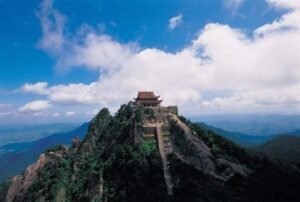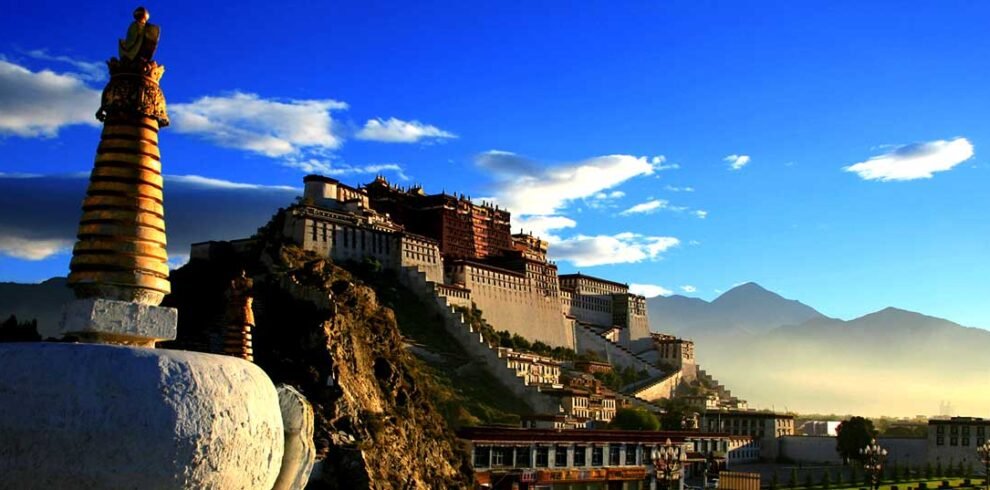Mount Wutai, also known as Wutaishan, is a sacred Buddhist mountain located in Shanxi province, China. "Wutai" means "Five Plateau" in Chinese, referring to the mountain's five main peaks, each of which is adorned with a temple complex.
These five summits are:
(1) North Peak (Beitai Ding):
The North Peak of Mount Wutai, known as Beitai Ding in Chinese, is one of the five main peaks of this sacred mountain in Shanxi province, China.
The North Peak is called Beitai Ding, which translates to "Northern Terrace Peak." It is situated in the northern part of Mount Wutai and is one of the five plateaus that give the mountain its name.
Beitai Ding is renowned for its stunning scenery and tranquil atmosphere. The peak is home to the Yedou Temple, one of the many Buddhist temples and monasteries that dot the landscape of Mount Wutai. Yedou Temple is dedicated to Manjushri Bodhisattva, the Bodhisattva of Wisdom, and is a place of pilgrimage and worship for Buddhists.
Yedou Temple, also known as Yedou Monastery, is a significant religious site on the North Peak. It features traditional Chinese architectural elements and intricate carvings, making it a visually stunning attraction for visitors. Pilgrims and tourists often visit Yedou Temple to pay their respects, offer prayers, and soak in the spiritual ambiance of the mountain.
In addition to its religious significance, the North Peak offers breathtaking views of the surrounding landscape. Visitors can enjoy hiking trails, lush forests, and serene natural surroundings while exploring the area around Beitai Ding.
Overall, the North Peak of Mount Wutai is a place of both natural beauty and spiritual importance, attracting visitors from all over the world who seek solace, enlightenment, and a deeper connection to Buddhist traditions.
(2) East Peak (Dongtai Ding):
Also known as Guayue Peak, this summit boasts the Shuxiang Temple, which is famous for its large statue of Manjushri Bodhisattva riding a lion. The East Peak of Mount Wutai, known as Dongtai Ding in Chinese, is another significant summit among the five main peaks of this revered mountain in Shanxi province, China.
Dongtai Ding translates to "Eastern Terrace Peak," indicating its location on the eastern side of Mount Wutai. It is one of the five plateaus that collectively form Mount Wutai, a UNESCO World Heritage Site and one of China's sacred Buddhist mountains.
The East Peak holds great spiritual significance for Buddhists, as it is believed to be the dwelling place of Manjushri Bodhisattva, the embodiment of wisdom in Mahayana Buddhism. Many temples and monasteries dedicated to Manjushri are located on the East Peak, making it a focal point for Buddhist pilgrimages and practices.
One of the most prominent temples on the East Peak is the Shuxiang Temple, also known as the Temple of Auspicious Fragrance. The Shuxiang Temple is famous for its large statue of Manjushri Bodhisattva riding a lion, symbolizing wisdom and courage. Visitors to the temple can admire its intricate architecture, colorful decorations, and serene atmosphere.
In addition to its religious significance, the East Peak offers stunning natural scenery, including lush forests, picturesque valleys, and panoramic views of the surrounding landscape. Hiking trails and pathways lead visitors through the mountain's pristine environment, allowing them to connect with nature while exploring its spiritual heritage.
Overall, the East Peak of Mount Wutai is a place of profound spiritual devotion, natural beauty, and cultural significance, attracting pilgrims, tourists, and seekers of enlightenment alike. It serves as a testament to the enduring influence of Buddhism in China and the reverence for sacred mountains in Buddhist tradition.
(3) South Peak (Nantai Ding):
The South Peak of Mount Wutai, known as Nantai Ding in Chinese, is one of the five main peaks of this sacred mountain located in Shanxi province, China.
Nantai Ding translates to "Southern Terrace Peak," indicating its location on the southern side of Mount Wutai. It is one of the five plateaus that collectively form Mount Wutai, a UNESCO World Heritage Site and one of the most important Buddhist pilgrimage destinations in China.
The South Peak holds great religious significance for Buddhists, as it is believed to be the dwelling place of Samantabhadra Bodhisattva, also known as Puxian Bodhisattva. Samantabhadra is associated with virtuous conduct and the practice of meditation, making the South Peak a place for pilgrims to seek blessings and spiritual guidance.
One of the most renowned temples on the South Peak is the Xiantong Temple, also known as the Temple of Primeval Purity. Xiantong Temple is one of the oldest and largest temples on Mount Wutai, dating back over 1,400 years to the Tang dynasty. The temple complex features a rich array of Buddhist art and architecture, including ancient statues, pagodas, and prayer halls.
In addition to its religious significance, the South Peak offers breathtaking natural scenery, including dense forests, meandering streams, and sweeping vistas. Visitors to the South Peak can enjoy hiking trails and scenic overlooks that provide panoramic views of the surrounding landscape. The tranquil environment of the mountain encourages contemplation and spiritual reflection, making it an ideal destination for those seeking inner peace and harmony.
Overall, the South Peak of Mount Wutai is a place of deep spiritual devotion, cultural heritage, and natural beauty, drawing pilgrims, tourists, and nature enthusiasts from around the world. It serves as a testament to the enduring legacy of Buddhism in China and the profound connection between spirituality and the natural world.
(4) West Peak (Xitai Ding):
Referred to as Wanghai Peak, this summit is known for the Pusading Temple, where pilgrims can find a collection of Buddhist scriptures carved on woodblocks. The West Peak of Mount Wutai, known as Xitai Ding in Chinese, is one of the five main peaks of this revered mountain located in Shanxi province, China.
Xitai Ding translates to "Western Terrace Peak," indicating its location on the western side of Mount Wutai. It is one of the five plateaus that collectively form Mount Wutai, a UNESCO World Heritage Site and one of China's most sacred Buddhist mountains.
The West Peak holds religious significance for Buddhists, as it is believed to be the dwelling place of Ksitigarbha Bodhisattva, also known as Dizang Bodhisattva. Ksitigarbha is revered for his compassion and vow to relieve suffering in the afterlife, making the West Peak a destination for pilgrims seeking blessings and guidance.
One of the notable temples on the West Peak is the Pusading Temple, also known as the Temple of Universal Peace. Pusading Temple is dedicated to Ksitigarbha Bodhisattva and is renowned for its collection of Buddhist scriptures carved on woodblocks, known as the Tripitaka Koreana. Visitors to the temple can explore its ancient halls, pagodas, and prayer rooms, experiencing the rich cultural heritage of Mount Wutai.
In addition to its religious significance, the West Peak offers picturesque natural scenery, including rugged cliffs, verdant forests, and cascading waterfalls. Hiking trails wind through the mountain's pristine environment, providing opportunities for visitors to connect with nature while admiring its spiritual splendor. The tranquil atmosphere of the West Peak invites contemplation and introspection, allowing pilgrims and tourists alike to find solace and serenity amid the beauty of Mount Wutai.
Overall, the West Peak of Mount Wutai is a place of profound spiritual devotion, cultural heritage, and natural wonder, attracting visitors from around the world who seek enlightenment, inspiration, and renewal. It stands as a testament to the enduring influence of Buddhism in China and the enduring bond between humanity and the sacred mountains of the world.
(5) Central Peak (Zhongtai Ding):
Known as Jinxiu Peak, it is the smallest of the five peaks but is significant for hosting the most sacred temple on Mount Wutai, the Xiantong Temple. The Central Peak of Mount Wutai, known as Zhongtai Ding in Chinese, is the focal point among the five main peaks of this revered mountain located in Shanxi province, China.
Zhongtai Ding translates to "Central Terrace Peak," highlighting its central location within the Mount Wutai complex. It serves as the heart of Mount Wutai, surrounded by the other four peaks, and is a significant pilgrimage destination for Buddhists.
The Central Peak holds immense religious significance, as it is believed to be the dwelling place of Bodhisattva Manjushri, the embodiment of wisdom. Manjushri is revered in Mahayana Buddhism as the patron Bodhisattva of Mount Wutai, making the Central Peak a primary site for pilgrimages and worship. The peak is also associated with the transmission of Buddhist teachings and the cultivation of wisdom and compassion.
The most sacred temple on the Central Peak is the Xiantong Temple, also known as the Temple of Primeval Purity. Xiantong Temple is one of the oldest and largest temples on Mount Wutai, dating back over 1,400 years to the Tang dynasty. The temple complex houses numerous halls, pagodas, and shrines dedicated to Manjushri and other Buddhist deities, attracting pilgrims and tourists alike.
In addition to its spiritual significance, the Central Peak is renowned for its cultural heritage, including ancient sculptures, paintings, and scriptures. Visitors to the Central Peak can explore the rich artistic and architectural traditions of Buddhism, admiring the intricate craftsmanship and symbolism found throughout the temple complex.
The Central Peak is surrounded by stunning natural landscapes, including lush forests, meandering streams, and scenic viewpoints. Hiking trails and pathways lead visitors through the mountain's pristine environment, offering opportunities for reflection and meditation amid the beauty of nature.
Overall, the Central Peak of Mount Wutai is a place of profound spiritual devotion, cultural heritage, and natural beauty, attracting pilgrims, tourists, and scholars from around the world. It stands as a testament to the enduring legacy of Buddhism in China and the timeless quest for wisdom and enlightenment.
In conclusion, each of these peaks is believed to be the dwelling place of different Bodhisattvas, making Mount Wutai an essential pilgrimage site for Buddhists. The entire area, with its temples, monasteries, and natural beauty, is designated as a UNESCO World Heritage Site. Pilgrims and tourists visit Mount Wutai to admire its religious architecture, stunning landscapes, and profound spiritual significance.
Overnight in the Hotel.
 Mount Wutai(འཇམ་དཔལ་དབྱངས་ཀྱི་གནས།):
Mount Wutai(འཇམ་དཔལ་དབྱངས་ཀྱི་གནས།):
 Mount Putuo(རི་བོ་གྲུ་འཛིན་འཕགས་པ་ཐུགས་རྗེ་ཆེན་པོའི་གནས།):
Mount Putuo(རི་བོ་གྲུ་འཛིན་འཕགས་པ་ཐུགས་རྗེ་ཆེན་པོའི་གནས།):









